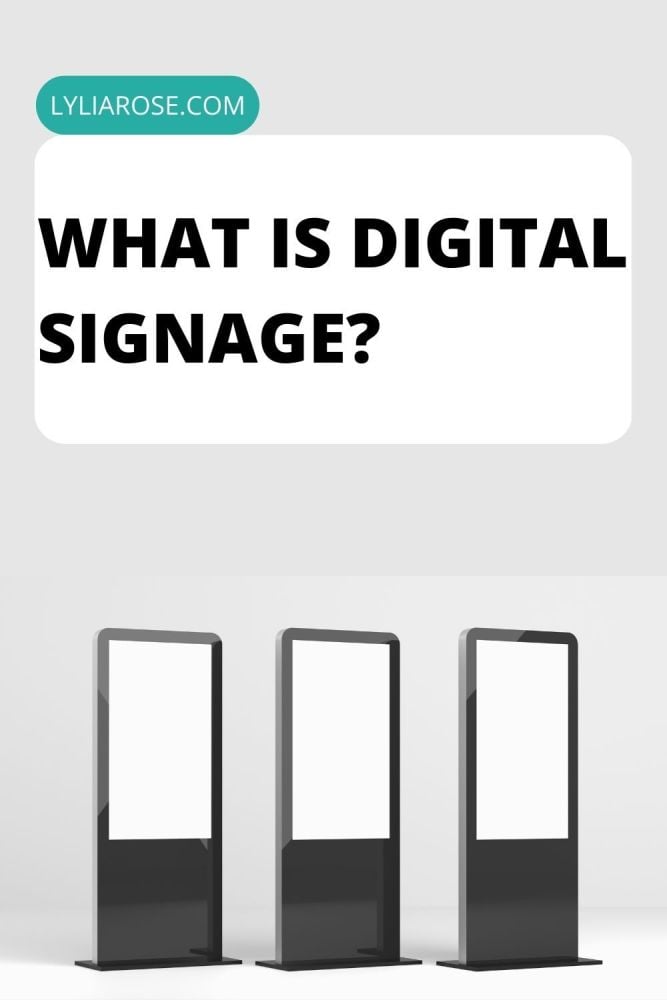What Is Digital Signage? How It Saves Businesses Time & Money
Posted on
Digital signage is a technology that has revolutionized the way businesses communicate with their customers. It's a powerful tool that can save businesses time and money, while also increasing their revenue and improving the customer experience. In this article, we'll take a closer look at what digital signage is and how it can benefit businesses.

What is digital signage?
Digital signage refers to the use of electronic displays to convey information, advertising, marketing messages and other content to a large audience. Digital signs can be found in a wide range of settings, from retail stores and restaurants to airports and stadiums.
Digital signage displays can take many forms, including large video walls, standalone displays, and interactive kiosks. They can also display a variety of media, including text, images, videos, and live data feeds.
One of the key benefits of digital signage is its flexibility. Content can be updated in real-time, allowing businesses to quickly and easily change the information displayed on their screens. This makes it easy to adapt to changing business needs, such as promoting new products, running seasonal campaigns, or highlighting special offers.
How do different businesses use digital signage?
Digital signage can be used in a variety of ways by different types of businesses to achieve different goals. Here are some examples of how businesses in various industries can use digital signage:
Retail
Retailers can use digital signage to promote products, showcase promotions and discounts, display social media feeds and reviews, and provide directions or wayfinding information to customers. Digital signage can also be used to highlight new arrivals or trending products, and to provide customers with personalized recommendations based on their shopping history.
Hospitality
In the hospitality industry, digital signage can be used to provide guests with information about hotel amenities and services, display event schedules, and promote dining options and specials. Hotels can also use digital signage to provide guests with local recommendations and attractions and to display weather and news updates.
Healthcare
In healthcare settings, digital signage can be used to provide patients with information about medical procedures and services, display wait times and queue information, and provide wayfinding and directional information. Medical practice businesses and healthcare facilities can also use digital signage to promote health and wellness tips, display educational videos, and provide real-time updates about emergencies or safety procedures.
Education
In education settings, digital signage can be used to display class schedules, campus maps, and news updates. Digital signage can also be used to promote student events and extracurricular activities, display safety alerts, and provide important announcements and reminders.
Transportation
In transportation settings, digital signage can be used to provide passengers with real-time arrival and departure information, display wayfinding and directional information, and promote services and amenities such as duty-free shopping or Wi-Fi.
These are just a few examples of how different businesses can use digital signage to achieve their specific goals. With the right strategy and implementation, digital signage can help businesses improve customer experiences, increase sales, and enhance engagement with their target audience.
What are the different types of digital signage displays available?
There are several different types of digital signage displays available, each with its own set of features and benefits. Some of the most common types of digital signage displays include:
-
Standalone displays: These displays are typically freestanding and can be placed in a variety of settings, from retail stores to airports. They come in a variety of sizes and can display a range of media, from static images to videos and animations.
-
Video walls: Video walls are large displays that consist of multiple screens arranged in a grid pattern. They can be used to create immersive and eye-catching displays that can be seen from a distance.
-
Interactive kiosks: Interactive kiosks are touch-screen displays that allow users to interact with content in a more immersive way. They can be used to provide information, collect data, or even facilitate transactions.
-
Outdoor displays: Outdoor displays are designed to withstand harsh weather conditions and can be used in a variety of outdoor settings, from sports arenas to transportation hubs. They are typically brighter and more durable than indoor displays.
-
LED displays: LED displays use light-emitting diodes to create bright, high-resolution displays. They are often used for large-scale displays, such as billboards or stadium screens.
How does digital signage save businesses time and money?
Digital signage can save businesses time and money in a number of ways. Here are some of the most significant benefits:
Reduced printing and distribution costs
Traditional print advertising and promotional materials can be costly to produce and distribute. Digital signage eliminates these costs by allowing businesses to create and display their content digitally. This can save businesses a significant amount of money in the long run. As digital signage company LOOK DS explain “Creating signage in print form is labor-intensive and expensive, not to mention the time it takes to print and update them [which would mean acquiring new ones]. With digital signage, you can do all that within a fraction of the time. Besides, you can update the display with just a few clicks.”
Increased efficiency
Digital signage can help businesses streamline their operations and improve efficiency. For example, digital signs can be used to display important information to employees, such as safety messages or shift schedules. This can save time and reduce the risk of errors.
Improved customer engagement
Digital signage can be used to create engaging and interactive experiences for customers. This can help businesses build stronger relationships with their customers and increase loyalty. For example, digital signs can be used to display personalized messages or to offer targeted promotions based on customer behavior.
Real-time updates
Digital signage allows businesses to update their content in real-time, which can be a huge time-saver. For example, a restaurant can update its menu items, prices, and promotions on-the-fly, without having to reprint menus or promotional materials.
Reduced waste
Traditional print advertising and promotional materials can generate a lot of waste, especially if they need to be updated frequently. Digital signage eliminates this waste by allowing businesses to update their content electronically.
Increased revenue
Digital signage can help businesses increase their revenue by promoting products and services more effectively. For example, a retail store can use digital signage to highlight new arrivals or offer special promotions, which can encourage customers to make purchases.
What are the best practices for creating effective digital signage content?
Creating effective digital signage content requires careful planning and consideration. The following best practices can help businesses create compelling content that engages their audience:
-
Firstly, it is important to keep the content simple and easy to read, as digital signage displays are often viewed from a distance. Using clear fonts, contrasting colors, and concise messaging can ensure that the content is easily digestible.
-
High-quality images and videos can help grab viewers' attention and make the content more engaging. It is important to make sure that the images and videos are high-resolution and optimized for the display size.
-
Updating the content regularly is key to keeping viewers engaged and interested. Real-time data feeds or social media feeds can help keep the content fresh and relevant.
-
Considering the audience when creating the content is crucial. Using messaging and visuals that resonate with the target audience, and taking their viewing habits and preferences into account, can help ensure that the content is more effective.
-
Incorporating a call to action can encourage viewers to take action. This could be making a purchase, signing up for a service, or visiting a specific location.
By following these best practices, businesses can create effective digital signage content that engages their audience and drives results.
What are some of the challenges that businesses may face when implementing a digital signage system, and how can they overcome these challenges?
When implementing a digital signage system, businesses may face a variety of challenges that can affect the effectiveness of their displays.
Here are some of the challenges:
-
Choosing the right hardware and software is critical, but can be a daunting task given the range of options available.
-
Creating effective content that resonates with the target audience can also be challenging, as can managing and updating content across multiple displays.
-
Ensuring compliance with regulations and maintaining and servicing the hardware are additional challenges that businesses may face.
-
Proper placement of the displays is essential to their effectiveness and ensuring proper connectivity and power supply can be a challenge, especially in large or complex installations.
To overcome these challenges:
-
Businesses should carefully evaluate their needs and budget when choosing hardware and software, seek out expert advice when needed, and invest in a content management system (CMS) to simplify content management.
-
Hiring a professional designer or content creator, or investing in training for staff, can help ensure effective content creation.
-
Familiarizing themselves with relevant regulations and working with experienced installers and IT professionals can help businesses ensure compliance and proper placement, connectivity, and power supply for their displays.
-
Developing a maintenance plan and scheduling regular inspections and repairs can help businesses maintain the effectiveness of their digital signage displays over time.
Conclusion
Digital signage is a powerful tool that can help businesses save time and money, while also increasing revenue and improving the customer experience. By using digital signage, businesses can create engaging and interactive experiences for their customers, streamline their operations, and reduce waste. With its flexibility and real-time updates, digital signage is a must-have technology for any business looking to stay competitive in today's fast-paced digital world.




